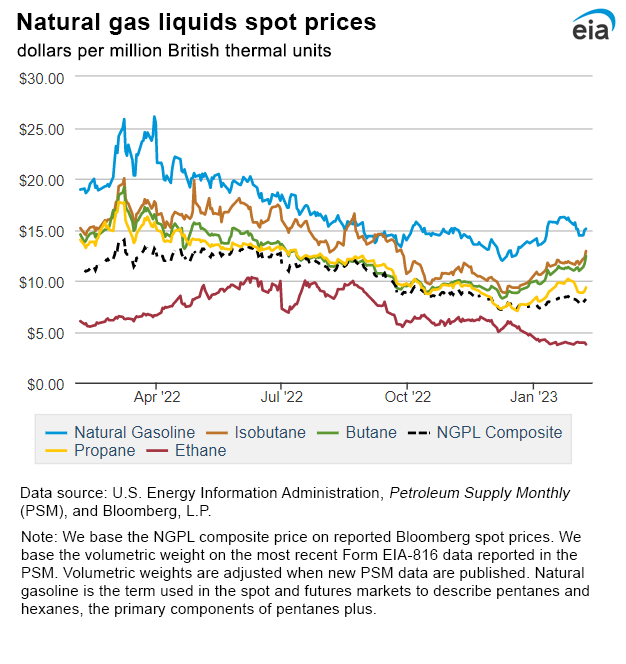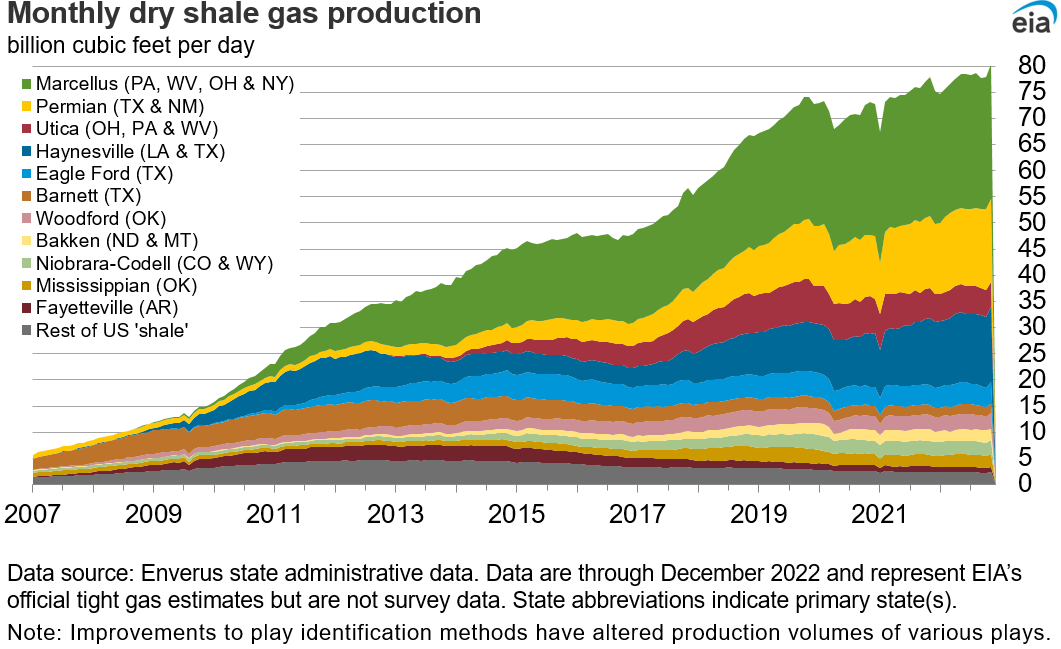In the News:
Horizontal wells produced 78% of all U.S. natural gas production in 2022
Natural gas gross withdrawals from horizontal wells in the United States increased 4.5 billion cubic feet per day (Bcf/d) in the first nine months of 2022 compared with 2021, and they accounted for 78% of all U.S. natural gas production. U.S. natural gas production has increased 78% since 2000, primarily due to increased horizontal drilling and improved hydraulic fracturing techniques in both oil and natural gas plays, which has gradually displaced the drilling of vertical wells.
In September 2022, 53% of all U.S. natural gas production came from horizontal wells in three plays: two natural gas plays—the Marcellus play in the Appalachian Basin and the Haynesville play in northwestern Louisiana—and one oil play—the Permian Basin in western Texas and southeastern New Mexico—which produces primarily oil with associated natural gas. In the first nine months of 2022, the Marcellus play produced 31.0 Bcf/d of natural gas, which is more than the 26.3 Bcf/d of natural gas produced from all vertical wells in the United States. When excluding the Haynesville and Permian plays, the Marcellus play produced more than the 29.0 Bcf/d produced from all other horizontal wells in the United States.
A horizontal well by its nature is longer compared with a vertical well targeting the same geologic formation. To drill from the surface to a given formation depth, a vertical well is drilled vertically down from the surface to a targeted rock formation. To create a horizontal section in that same formation, a horizontal well requires the same initial vertical section, followed by a curve from the vertical section to orient the wellbore horizontally within the formation. The drilling then continues to the desired lateral length. Because horizontal wells are longer than vertical wells, they are more expensive, and the drilling process is more complex. On average, for a given formation, a horizontal well is substantially more productive than a vertical well producing from the same rock because the well bore makes contact with more of the source rock. In January 2000, 96% of all U.S. natural gas production came from vertical wells. By September 2022, the share of U.S. production from vertical wells declined to 22%.
The mix of horizontal and vertical wells has changed substantially since 2000 due to multiple factors. The 2008 recession directly affected natural gas prices and reduced drilling activity in oil and natural gas fields, as did the oil price decline in 2015. Both of these events were followed by a greater decrease in vertical wells drilled than horizontal wells drilled. The COVID-19 pandemic in 2020 and associated crude oil and natural gas price declines were also followed by a drop in drilling activity that affected more horizontal wells than vertical wells.
Market Highlights:
(For the week ending Wednesday, February 8, 2023)Prices
- Henry Hub spot price: The Henry Hub spot price fell 24 cents from $2.66 per million British thermal units (MMBtu) last Wednesday to $2.42/MMBtu yesterday.
- Henry Hub futures prices: The price of the March 2023 NYMEX contract decreased 7.2 cents, from $2.468/MMBtu last Wednesday to $2.396/MMBtu yesterday. The price of the 12-month strip averaging March 2023 through February 2024 futures contracts declined 7.2 cents to $3.196/MMBtu.
- Select regional spot prices: Natural gas spot prices fell across all locations this report week (Wednesday, February 1 to Wednesday, February 8). Week-over-week price declines ranged from a decrease of $0.26/MMBtu at Chicago Citygate to a decrease of $13.26/MMBtu at the SoCal Citygate.
- In the Northeast, at the Algonquin Citygate, which serves Boston-area consumers, the price fell $9.64/MMBtu, from $12.16/MMBtu last Wednesday to $2.52/MMBtu yesterday, as below-normal temperatures last week gave way to above-normal temperatures this week. Last Thursday, February 2, the price at Algonquin Citygate spiked to $71.42/MMBtu, the highest daily price since January 4, 2018, when it reached $78.98/MMBtu. Temperatures in New England fell rapidly last Thursday through Saturday. In the Boston Area, temperatures fell from an average of 31°F on Thursday, which is 1°F above normal, to 4°F on Saturday, which is 26°F below normal. At the Transcontinental Pipeline Zone 6 trading point for New York City, the price decreased $2.49 from $4.61/MMBtu last Wednesday to $2.12/MMBtu yesterday, after reaching a weekly high of $28.36/MMBtu on Thursday. Total consumption of natural gas in the Northeast averaged 33.8 billion cubic feet per day (Bcf/d) over the first three days of the report week (February 2–February 4), 38% higher than the average daily consumption of 24.4 Bcf/d over the rest of the report week, according to data from S&P Global Commodity Insights.
- In the West, prices fell this week as a result of warmer weather and reduced consumption of natural gas. The price at PG&E Citygate in Northern California fell $11.71, down from $16.74/MMBtu last Wednesday to $5.03/MMBtu yesterday. The price at SoCal Citygate in Southern California decreased $13.25 from $18.50/MMBtu last Wednesday to $5.25/MMBtu yesterday. In the Sacramento Area, temperatures averaged 48°F this report week, which is 2°F higher than last week, leading to 13 fewer heating degree days (HDDs) than last report week. In the Riverside Area, inland from Los Angeles, temperatures averaged 56°F, leading to 20 fewer HDDs than last week. Total consumption of natural gas in California fell 6% (0.5 Bcf/d) week over week to average 6.6 Bcf/d this report week, according to data from S&P Global Commodity Insights.
- In the Pacific Northwest, the price at Sumas on the Canada-Washington border fell $6.33 from $10.91/MMBtu last Wednesday to $4.58/MMBtu yesterday. The price at Malin, Oregon, the northern delivery point into the PG&E service territory, fell $8.11 from $12.90/MMBtu last Wednesday to $4.79/MMBtu yesterday. Temperatures in the Seattle City Area averaged 45°F this report week, which is 6°F higher than last week, leading to 43 fewer HDDs than last week and 18 fewer than normal for this time of year. Total consumption of natural gas in the Pacific Northwest fell 18% (0.6 Bcf/d) to an average of 2.6 Bcf/d this report week, according to data from S&P Global Commodity Insights.
- The price at the Waha Hub in West Texas, which is located near Permian Basin production activities, fell 47 cents this report week, from $2.37/MMBtu last Wednesday to $1.90/MMBtu yesterday. The Waha Hub traded 52 cents below the Henry Hub price yesterday, compared to last Wednesday when it traded 29 cents below the Henry Hub price. On Monday El Paso Natural Gas Company LLC (EPNG) provided an updated notice to its force majeure on Line 2000, which moves natural gas west out of the Permian Basin. Having received approval from the Pipeline and Hazardous Materials Safety Administration (PHMSA) to lift fully the pressure restriction on the line, EPNG has begun implementing its re-start plan to return Line 2000 to commercial service, and it anticipates lifting the associated force majeure on February 15, 2023. The return of Line 2000 to full service will increase natural gas takeaway capacity out of West Texas by close to 0.5 Bcf/d, increasing supply into the Desert Southwest.
- International futures prices: International natural gas futures prices decreased this report week. According to Bloomberg Finance, L.P., weekly average front-month futures prices for liquefied natural gas (LNG) cargoes in East Asia decreased $1.13 to a weekly average of $18.30/MMBtu. Natural gas futures for delivery at the Title Transfer Facility (TTF) in the Netherlands, the most liquid natural gas market in Europe, decreased 21 cents to a weekly average of $17.83/MMBtu. In the same week last year (week ending February 9, 2022), the prices in East Asia and at TTF were $24.96/MMBtu and $26.44/MMBtu, respectively.
- Natural gas plant liquids (NGPL) prices: The natural gas plant liquids composite price at Mont Belvieu, Texas, fell by 27 cents/MMBtu, averaging $7.98/MMBtu for the week ending February 8. Ethane prices rose 1%, while average weekly natural gas prices at the Houston Ship Channel fell 18% week over week, widening the ethane premium to natural gas by 34%. Ethylene spot prices rose 1%, widening the ethylene to ethane premium by 1%. Propane prices fell 8%, while the weekly average price of Brent crude oil fell 3%, resulting in a 7% increase in the propane discount relative to crude oil. Normal butane prices rose 3% and isobutane prices rose 4%. Natural gasoline prices fell 6%.
Daily spot prices by region are available on the EIA website.
Supply and Demand
- Supply: According to data from S&P Global Commodity Insights, the average total supply of natural gas fell by 0.2% (0.2 Bcf/d) compared with the previous report week. Dry natural gas production remained unchanged at 98.8 Bcf/d, and average net imports from Canada decreased by 5.7% (0.3 Bcf/d) from last week.
- Demand: Total U.S. consumption of natural gas fell by 6.6% (6.9 Bcf/d) compared with the previous report week, according to data from S&P Global Commodity Insights. Natural gas consumed for power generation declined by 6.1% (2.0 Bcf/d) week over week. Industrial sector consumption decreased by 2.4% (0.6 Bcf/d) week over week, while consumption in the residential and commercial sectors declined by 9.2% (4.3 Bcf/d). Natural gas exports to Mexico decreased 1.3% (0.1 Bcf/d). Natural gas deliveries to U.S. LNG export facilities (LNG pipeline receipts) averaged 12.5 Bcf/d, or 0.2 Bcf/d lower than last week.
Liquefied Natural Gas (LNG)
- Pipeline receipts: Overall natural gas deliveries to U.S. LNG export terminals decreased by 1.5% (0.2 Bcf/d) week over week to 12.5 Bcf/d. Feed gas deliveries to terminals in South Louisiana fell by 1.5% (0.1 Bcf/d) to 8.8 Bcf/d, while feed gas deliveries to East Coast terminals fell 8.5% (0.1 Bcf/d) to 1.1 Bcf/d over the same period. Deliveries to all other terminals were essentially flat, according to data from S&P Global Commodity Insights.
- Vessels departing U.S. ports: Twenty-four LNG vessels (ten from Sabine Pass, five from Corpus Christi, four from Cameron, two each from Calcasieu Pass and Cove Point, and one from Elba Island) with a combined LNG-carrying capacity of 90 Bcf departed the United States between February 2 and February 8, according to shipping data provided by Bloomberg Finance, L.P.
Rig Count
- According to Baker Hughes, for the week ending January 31, the natural gas rig count decreased by 2 rigs from the previous week to 158 rigs, as 2 rigs were added in the Permian Basin and 4 rigs were dropped in unidentified basins. The oil rig count decreased by 10 rigs from the previous week to 599 rigs, as 5 rigs were dropped in the Permian Basin, 1 rig was dropped in the Granite Wash, and 4 rigs were dropped in unidentified basins. The total rig count, which includes 2 miscellaneous rigs, stands at 759 rigs, 12 fewer than last week.
Storage
- The net withdrawals from storage totaled 217 Bcf for the week ending February 3, compared with the five-year (2018–2022) average net withdrawals of 171 Bcf and last year's net withdrawals of 228 Bcf during the same week. Working natural gas stocks totaled 2,366 Bcf, which is 117 Bcf (5%) more than the five-year average and 233 Bcf (11%) more than last year at this time.
- According to The Desk survey of natural gas analysts, estimates of the weekly net change to working natural gas stocks ranged from net withdrawals of 184 Bcf to 215 Bcf, with a median estimate of 201 Bcf.
- The average rate of withdrawals from storage is 16% lower than the five-year average so far in the withdrawal season (November through March). If the rate of withdrawals from storage matched the five-year average of 12.8 Bcf/d for the remainder of the withdrawal season, the total inventory would be 1,649 Bcf on March 31, which is 117 Bcf higher than the five-year average of 1,532 Bcf for that time of year.
See also:
Top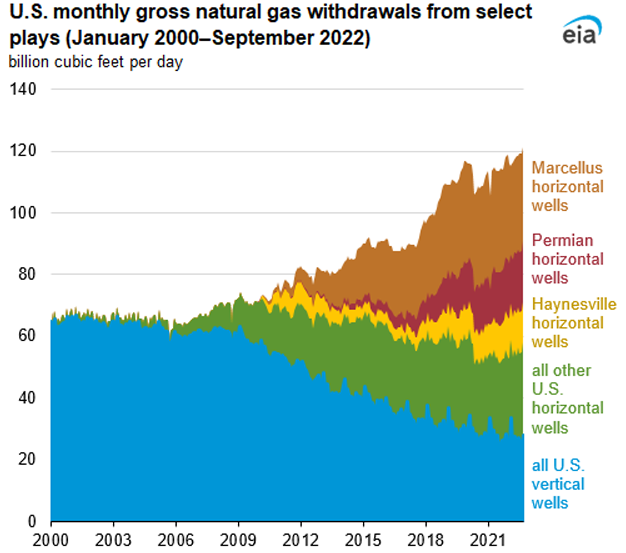
Data source: U.S. Energy Information Administration and Enverus DrillingInfo
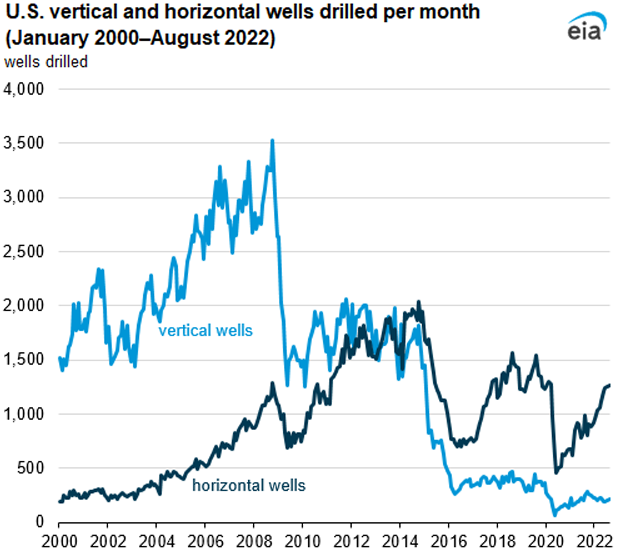
Data source: U.S. Energy Information Administration and Enverus DrillingInfo
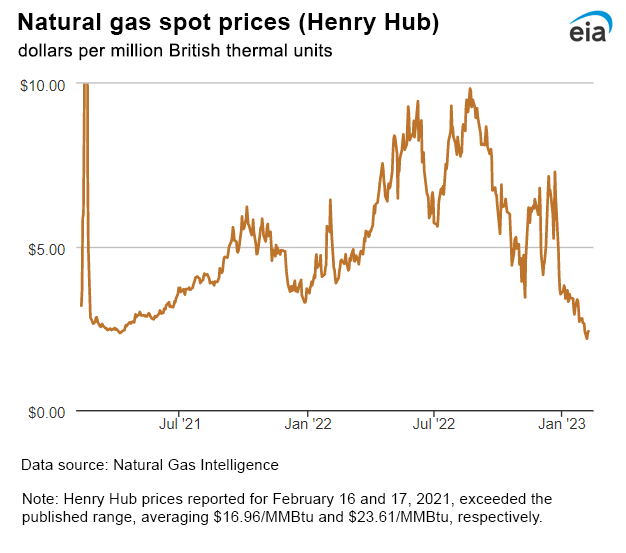
| Spot Prices ($/MMBtu) | Thu, 02-Feb |
Fri, 03-Feb |
Mon, 06-Feb |
Tue, 07-Feb |
Wed, 08-Feb |
|---|---|---|---|---|---|
| Henry Hub |
2.65 |
2.40 |
2.19 |
2.35 |
2.42 |
| New York |
28.36 |
3.52 |
2.10 |
2.43 |
2.12 |
| Chicago |
2.81 |
2.33 |
2.17 |
2.38 |
2.44 |
| Cal. Comp. Avg.* |
5.08 |
4.16 |
4.15 |
4.36 |
4.93 |
| Futures ($/MMBtu) | |||||
| March contract | 2.456 |
2.410 |
2.457 |
2.584 |
2.396 |
| April contract |
2.522 |
2.480 |
2.535 |
2.664 |
2.477 |
| *Avg. of NGI's reported prices for: Malin, PG&E Citygate, and Southern California Border Avg. | |||||
| Source: NGI's Daily Gas Price Index | |||||
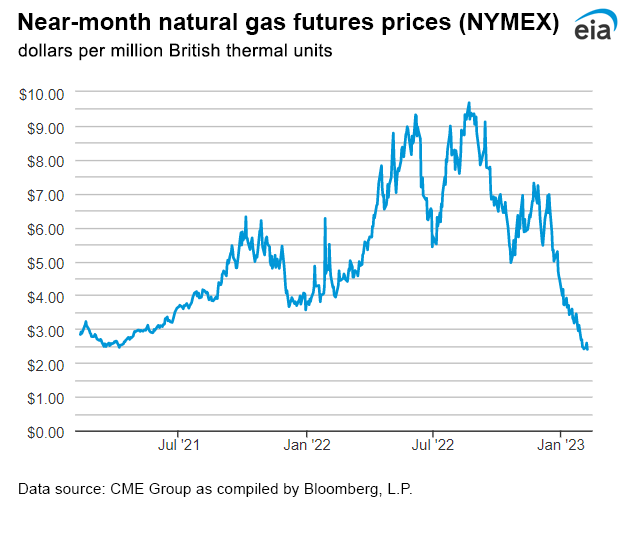
| U.S. natural gas supply - Gas Week: (2/2/23 - 2/8/23) | |||
|---|---|---|---|
Average daily values (billion cubic feet) |
|||
this week |
last week |
last year |
|
| Marketed production | 110.9 |
110.6 |
102.4 |
| Dry production | 98.8 |
98.8 |
90.8 |
| Net Canada imports | 5.5 |
5.8 |
7.7 |
| LNG pipeline deliveries | 0.2 |
0.1 |
0.3 |
| Total supply | 104.4 |
104.7 |
98.8 |
|
Data source: S&P Global Commodity Insights | |||
| U.S. natural gas consumption - Gas Week: (2/2/23 - 2/8/23) | |||
|---|---|---|---|
Average daily values (billion cubic feet) |
|||
this week |
last week |
last year |
|
| U.S. consumption | 98.3 |
105.2 |
108.0 |
| Power | 31.0 |
33.0 |
30.6 |
| Industrial | 24.9 |
25.5 |
26.1 |
| Residential/commercial | 42.4 |
46.7 |
51.3 |
| Mexico exports | 5.1 |
5.2 |
5.5 |
| Pipeline fuel use/losses | 7.5 |
7.8 |
7.5 |
| LNG pipeline receipts | 12.5 |
12.7 |
12.6 |
| Total demand | 123.3 |
130.8 |
133.6 |
|
Data source: S&P Global Commodity Insights | |||
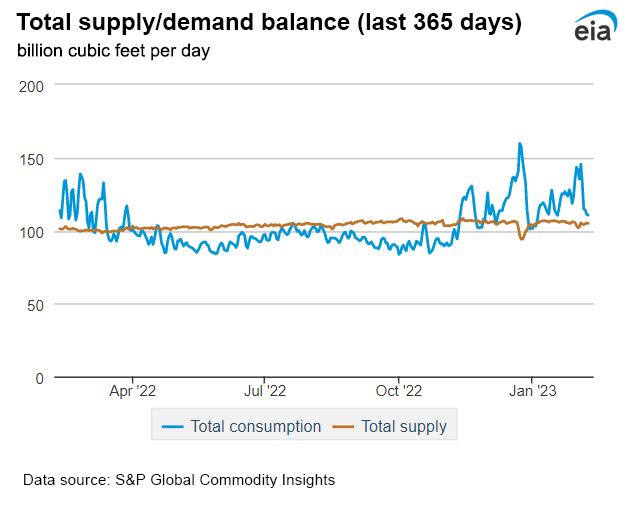
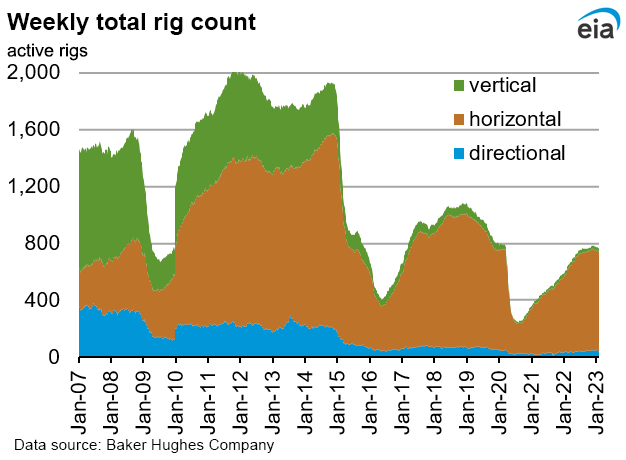
| Rigs | |||
|---|---|---|---|
Tue, January 31, 2023 |
Change from |
||
last week |
last year |
||
| Oil rigs | 599 |
-1.6% |
20.5% |
| Natural gas rigs | 158 |
-1.3% |
36.2% |
| Note: Excludes any miscellaneous rigs | |||
| Rig numbers by type | |||
|---|---|---|---|
Tue, January 31, 2023 |
Change from |
||
last week |
last year |
||
| Vertical | 21 |
0.0% |
-12.5% |
| Horizontal | 700 |
-0.7% |
26.1% |
| Directional | 38 |
-15.6% |
11.8% |
| Data source: Baker Hughes Company | |||
| Working gas in underground storage | ||||
|---|---|---|---|---|
Stocks billion cubic feet (Bcf) |
||||
| Region | 2023-02-03 |
2023-01-27 |
change |
|
| East | 529 |
578 |
-49 |
|
| Midwest | 641 |
708 |
-67 |
|
| Mountain | 120 |
132 |
-12 |
|
| Pacific | 124 |
140 |
-16 |
|
| South Central | 951 |
1,025 |
-74 |
|
| Total | 2,366 |
2,583 |
-217 |
|
| Data source: U.S. Energy Information Administration Form EIA-912, Weekly Underground Natural Gas Storage Report | ||||
| Working gas in underground storage | |||||
|---|---|---|---|---|---|
Historical comparisons |
|||||
Year ago (2/3/22) |
5-year average (2018-2022) |
||||
| Region | Stocks (Bcf) |
% change |
Stocks (Bcf) |
% change |
|
| East | 493 |
7.3 |
513 |
3.1 |
|
| Midwest | 561 |
14.3 |
600 |
6.8 |
|
| Mountain | 123 |
-2.4 |
128 |
-6.3 |
|
| Pacific | 183 |
-32.2 |
206 |
-39.8 |
|
| South Central | 774 |
22.9 |
803 |
18.4 |
|
| Total | 2,133 |
10.9 |
2,249 |
5.2 |
|
| Data source: U.S. Energy Information Administration Form EIA-912, Weekly Underground Natural Gas Storage Report | |||||
| Temperature – heating & cooling degree days (week ending Feb 02) | ||||||||
|---|---|---|---|---|---|---|---|---|
HDDs |
CDDs |
|||||||
| Region | Current total |
Deviation from normal |
Deviation from last year |
Current total |
Deviation from normal |
Deviation from last year |
||
| New England | 222 |
-51 |
-103 |
0 |
0 |
0 |
||
| Middle Atlantic | 216 |
-46 |
-92 |
0 |
0 |
0 |
||
| E N Central | 303 |
12 |
-5 |
0 |
0 |
0 |
||
| W N Central | 355 |
51 |
57 |
0 |
0 |
0 |
||
| South Atlantic | 142 |
-35 |
-68 |
9 |
2 |
7 |
||
| E S Central | 167 |
-13 |
-21 |
0 |
-1 |
0 |
||
| W S Central | 172 |
42 |
59 |
0 |
-4 |
0 |
||
| Mountain | 276 |
54 |
39 |
0 |
-1 |
0 |
||
| Pacific | 142 |
29 |
23 |
0 |
-1 |
0 |
||
| United States | 226 |
8 |
-9 |
2 |
0 |
1 |
||
|
Data source: National Oceanic and Atmospheric Administration Note: HDDs=heating degree days; CDDs=cooling degree days | ||||||||
Average temperature (°F)
7-day mean ending Feb 02, 2023
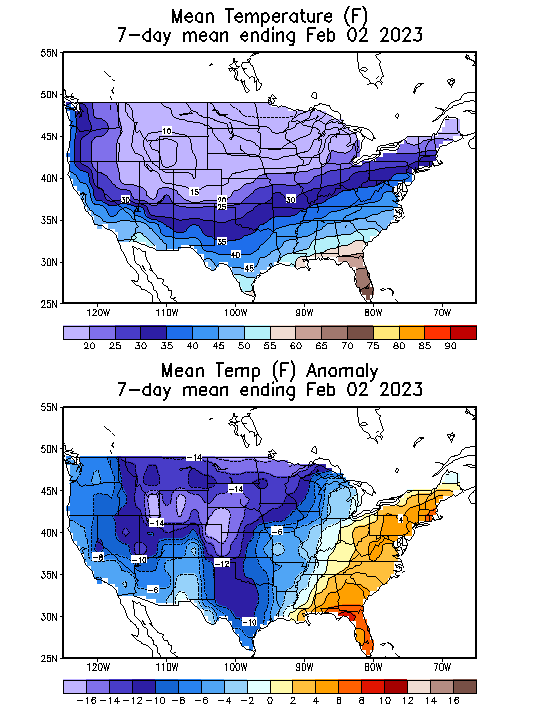
Data source: National Oceanic and Atmospheric Administration
Deviation between average and normal temperature (°F)
7-day mean ending Feb 02, 2023

Data source: National Oceanic and Atmospheric Administration

